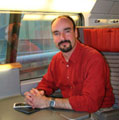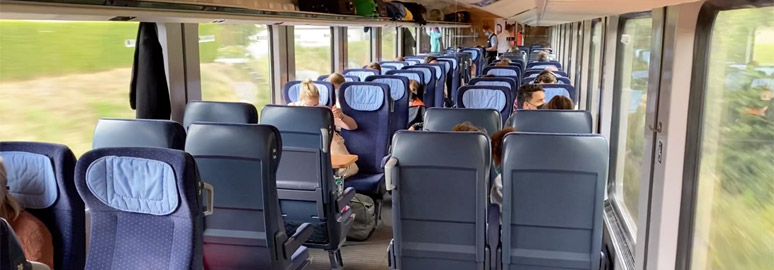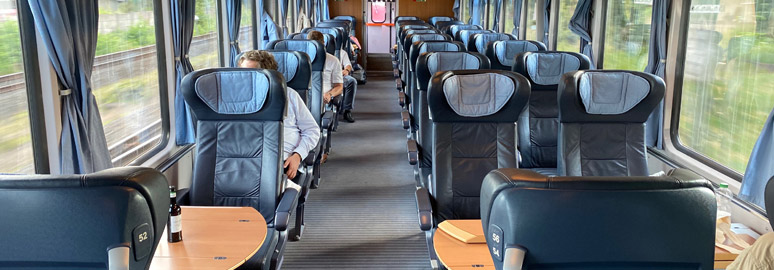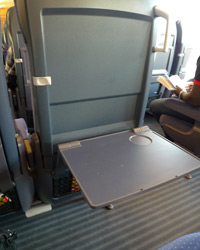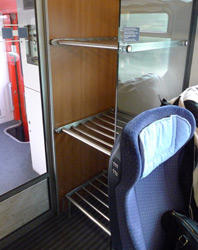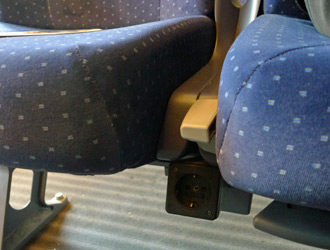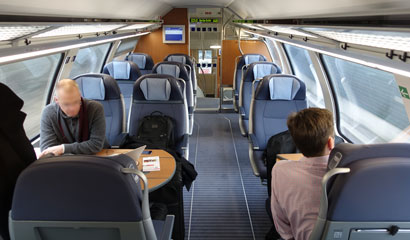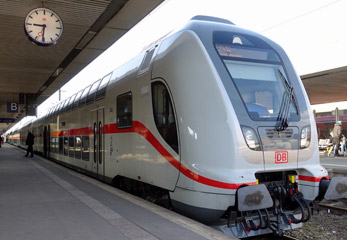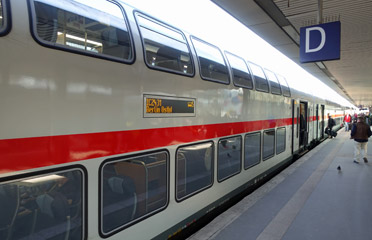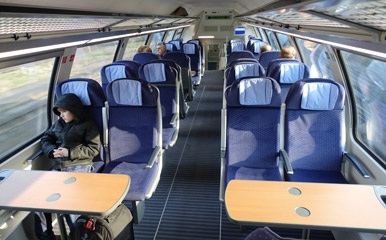What are German InterCity trains like?
Deutsche Bahn's (German Railways) InterCity trains might not be as fast or glamorous as their high-speed ICE trains, but these second-rank expresses still reach 200 km/h (125mph) with smooth-riding and spacious carriages, and usually some form of catering.
These trains run on many internal routes in Germany, including Cologne-Hamburg and the Cologne-Mainz route via the scenic Rhine Valley. They also run on international routes between Amsterdam & Berlin, and on some routes into Luxembourg, Austria & Switzerland. Double-deck InterCity trains entered service on a couple of Intercity routes in 2016, notably Hanover-Leipzig and Cologne-Dresden.
A German Intercity train at Hamburg Hbf.
2nd class seating is usually in open-plan saloons like this, most seats unidirectional, but with some tables for 4. Sometimes you'll find 2nd class compartment cars with side corridor and ten 6-seat compartments Larger photo.
Some first class cars are open-plan saloons (grossraumwagen in German) like this. Larger photo.
Other 1st class cars have seats in traditional 6-seat compartments with side corridor like this. Sometimes you find both types on one train and have a choice, sometimes a given train only has one type in a given class, either saloon or compartment. Larger photo. Larger photo.
Bistro car
Most Intercity trains used to have a bistro car, these were getting old and were withdrawn from service from all German Intercity trains in December 2023. They are replaced by an extra 1st class car and a refreshment trolley. You are of course free to bring your own food & drink, including some beer or wine if you like.
Travel tips
-
1st or 2nd class?
2nd class is absolutely fine for the majority of travellers, there's no need to go 1st class unless you don't mind the extra cost. But see what prices you get at int.bahn.de because sometimes 1st class doesn't cost much more than 2nd.
-
Seat reservations are optional
It's not usually necessary to reserve a seat on German trains, you can just get on and sit in any empty unreserved seat. However, it's a good idea at busy times such as Fridays. Reserving a seat costs €5.50 2nd class or €6.90 1st class.
When booking at int.bahn.de you can request a window or aisle seat, or a seat with a table, meaning face-to-face seats at a fixed wooden table as shown in the photos above - all seats in fact have small drop-down tables. On most German IC trains you can select your seat from a seat map when using int.bahn.de.
-
Saloon or compartment?
If you choose to reserve, the system asks you if you prefer open-plan seating (saloon or Grossraumwagen in German) or a seat in a traditional coach with a side-corridor and 6-seater-compartments. That doesn't mean a given train necessarily has both types of seating in both classes, but it'll ask you anyway! Most people generally prefer open-plan saloon seating, and this is better for viewing scenery as you can see out diagonally though many windows, not just directly sideways from one window as in a compartment, But if you are a small group or family of 5-6 people it can be fun to book seats in a compartment (Abteil in German).
-
Boarding your train
As with virtually all European trains, there's no check-in. Just stroll into the station, find your train and get on, any time before it leaves. The doors may be closed a minute before departure.
-
On the seat reservation displays above each seat
Small LED displays above each seat show which seats are reserved between which stations, and which seats are free. You may see these messages:
ggf. freigeben - this is a last-minute reservation seat. You can sit in it if you like, but will have to move if someone shows up with a reservation.
ggf. reserviert - this means the train's on-board reservation system hasn't been updated with the latest information from the main DB reservation system. Usually all of the seats show this message if this happens. Seat reservations are still valid, but cannot be shown on the LED displays, so you can sit in these seats but you could be asked to move if someone shows up with a reservation.
bahn.comfort - travellers holding a frequent traveller BahnCard have priority for these seats. You can sit in these seats but someone with a BahnCard may show up and claim it. Though how they'd know you didn't have a BahnCard and so ask you to move is another question!
Schwerbehinderte means that seat is reserved for people with disabilities.
-
Luggage
The only luggage limit is what you can carry or pull with you. There's plenty of luggage space in both classes, the racks above your seat will take anything up to and including backpack-size or there are racks at the end of the car which will take big suitcases.
-
Power sockets, WiFi & toilets
There are power sockets at all seats in both classes. IC trains are being fitted with WiFi, but not all cars have it yet. Every car has at least one toilet.
-
Bicycles
Bicycles can be taken on most InterCity trains, bike spaces must be booked in advance, you can add a bike to your booking at int.bahn.de.
-
First class lounges
If you have a 1st class Flexpreis ticket (but not advance-purchase Sparpreis, Super Sparpreis or a railpass) you can use the DB lounges at major German stations, with complimentary tea, coffee, juice, wine & beer, see more about DB Lounges.
Double-deck IC2 trains
Double-deck IC2 Intercity trains entered service in 2016 on a couple of routes, notably Cologne-Dresden and Hannover-Leipzig. There are 1st & 2nd class sections both upstairs and downstairs. It's just 7 steps, wide, easy and with good handrails from the entrance to the upper deck, and several steps down to the lower one. DB have also taken over some former Westbahn double-deck electric units which also now operate some Intercity services. IC2 trains are 'push-pull' which means they have a locomotive at one end and a driving cab at the other, and can operate in either direction with the locomotive either pulling or pushing.
